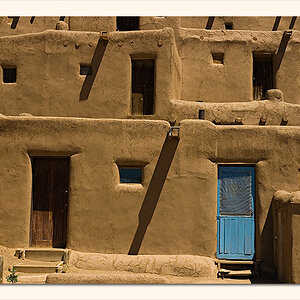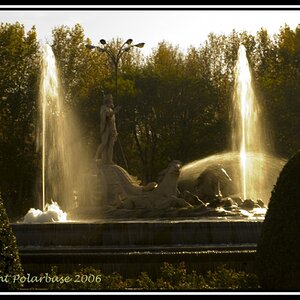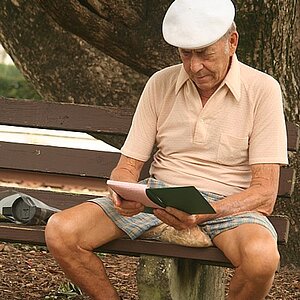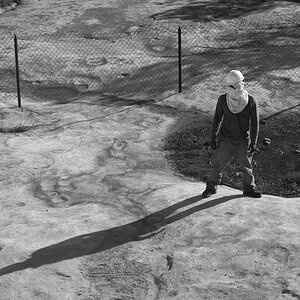Pure
TPF Noob!
- Joined
- Oct 22, 2008
- Messages
- 421
- Reaction score
- 1
- Can others edit my Photos
- Photos NOT OK to edit
Today UPS dropped off my new toy, a Kenko Pro 300 1.4x TC for Nikon AF-D. And of course a baseball game was going on. What a perfect chance to test it out! Here are my initial impressions.
I took it out of the box, and found it to be well constructed with metal mounts and a sturdy feeling to it [heavy].
Attaching it to my D90 was a dream, a snug fit!! With my 80-200mm f2.8 attached, there was some rotational movement, but BARELY noticeable without trying. the lens/TC only twist if you try and move it, not if you're just moving the zoom or focus rings.
In the field I found it to focus about 80% as fast as AF-D alone, plenty fast for sports. The TC does not modify the focal length and aperture, so when shooting at 280mm @ f/5.6, it still shows 200mm @ f/4 in camera. I also noticed an increase of Chromatic Aberration on the white jersey's. In the harsh lighting, CA was noticeable, much more than the 80-200mm alone.
Pro's
Well Constructed
Focuses with AF-D [screw] and AF-S
Hoya Multi-coated glass
Cheap, $200
Adds reach
Con's
Slows AF a bit, not that much
Chromatic Aberration increases especially in harsh lighting
Not as good as Nikkor glass
DOES NOT MODIFY APERTURE OR FOCAL LENGTH
Final Notes
I'd definitely recommend this TC if you want more range without having to buy a new lens. While the TC is no excuse for a new longer lens, it does do the job for a fraction of the price.
PLEASE NOTE: This TC, just like all TC's will make all glass worse. If you put this on a crappy piece of glass, expect the same from your pictures. I'd recommend only using this TC on good glass, like primes or pro zoom's. No 18-200mm lenses here.
If you have any questions, just ask here, or at my e-mail ccwbassett [AT] yahoo (DOT) [COM]
PICTURES!!!
\/\/\/\/ This is NOT a crop of the below picture.




I took it out of the box, and found it to be well constructed with metal mounts and a sturdy feeling to it [heavy].
Attaching it to my D90 was a dream, a snug fit!! With my 80-200mm f2.8 attached, there was some rotational movement, but BARELY noticeable without trying. the lens/TC only twist if you try and move it, not if you're just moving the zoom or focus rings.
In the field I found it to focus about 80% as fast as AF-D alone, plenty fast for sports. The TC does not modify the focal length and aperture, so when shooting at 280mm @ f/5.6, it still shows 200mm @ f/4 in camera. I also noticed an increase of Chromatic Aberration on the white jersey's. In the harsh lighting, CA was noticeable, much more than the 80-200mm alone.
Pro's
Well Constructed
Focuses with AF-D [screw] and AF-S
Hoya Multi-coated glass
Cheap, $200
Adds reach
Con's
Slows AF a bit, not that much
Chromatic Aberration increases especially in harsh lighting
Not as good as Nikkor glass
DOES NOT MODIFY APERTURE OR FOCAL LENGTH
Final Notes
I'd definitely recommend this TC if you want more range without having to buy a new lens. While the TC is no excuse for a new longer lens, it does do the job for a fraction of the price.
PLEASE NOTE: This TC, just like all TC's will make all glass worse. If you put this on a crappy piece of glass, expect the same from your pictures. I'd recommend only using this TC on good glass, like primes or pro zoom's. No 18-200mm lenses here.
If you have any questions, just ask here, or at my e-mail ccwbassett [AT] yahoo (DOT) [COM]
PICTURES!!!
\/\/\/\/ This is NOT a crop of the below picture.








![[No title]](/data/xfmg/thumbnail/35/35270-a66987e049fb56c03e604b4c77910b81.jpg?1619736972)



![[No title]](/data/xfmg/thumbnail/42/42483-f2f2bc205a7f02ea47df4ffc45d86e24.jpg?1619740195)






![[No title]](/data/xfmg/thumbnail/32/32635-be18e952e67667cbb1525b4b057b6423.jpg?1619735554)